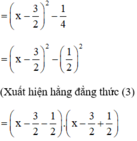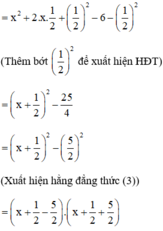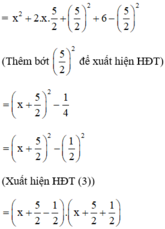Phân tích các đa thức sau thành nhân tử
a, x2 - 3x + 2
b, x2 + x - 6
c, x2 + 5x + 6
Hãy nhập câu hỏi của bạn vào đây, nếu là tài khoản VIP, bạn sẽ được ưu tiên trả lời.


a) \(=x\left(x-5\right)+\left(x-5\right)^2=\left(x-5\right)\left(x+x-5\right)=\left(x-5\right)\left(2x-5\right)\)
b) \(=x^2-2.x.10+10^2=\left(x-10\right)^2\)
c) \(=x\left(x+3\right)+2\left(x+3\right)=\left(x+3\right)\left(x+2\right)\)

a) \(=x^4-14x^2+40-72=x^4-14x^2-32=\left(x-4\right)\left(x+4\right)\left(x^2+2\right)\)
b) \(=\left(x^2+5x+4\right)\left(x^2+5x+6\right)+1=\left(x^2+5x\right)^2+2\left(x^2+5x\right)+1=\left(x^2+5x+1\right)^2\)
c) \(=x^4+3x^3-3x^2+3x^3+9x^2-9x+x^2+3x-3-5=x^4+6x^3+7x^2-6x-8=\left(x-1\right)\left(x+1\right)\left(x+2\right)\left(x+4\right)\)
a: Ta có: \(\left(x^2-4\right)\left(x^2-10\right)-72\)
\(=x^4-14x^2-32\)
\(=\left(x^2-16\right)\left(x^2+2\right)\)
\(=\left(x-4\right)\left(x+4\right)\left(x^2+2\right)\)
b: Ta có: \(\left(x+1\right)\left(x+2\right)\left(x+3\right)\left(x+4\right)+1\)
\(=\left(x^2+5x+6\right)\left(x^2+5x+4\right)+1\)
\(=\left(x^2+5x\right)^2+10\left(x^2+5x\right)+24+1\)
\(=\left(x^2+5x+1\right)^2\)

Cách 1: Tách một hạng tử thành tổng hai hạng tử để xuất hiện nhân tử chung.
a) x2 – 3x + 2
= x2 – x – 2x + 2 (Tách –3x = – x – 2x)
= (x2 – x) – (2x – 2)
= x(x – 1) – 2(x – 1) (Có x – 1 là nhân tử chung)
= (x – 1)(x – 2)
Hoặc: x2 – 3x + 2
= x2 – 3x – 4 + 6 (Tách 2 = – 4 + 6)
= x2 – 4 – 3x + 6
= (x2 – 22) – 3(x – 2)
= (x – 2)(x + 2) – 3.(x – 2) (Xuất hiện nhân tử chung x – 2)
= (x – 2)(x + 2 – 3) = (x – 2)(x – 1)
b) x2 + x – 6
= x2 + 3x – 2x – 6 (Tách x = 3x – 2x)
= x(x + 3) – 2(x + 3) (có x + 3 là nhân tử chung)
= (x + 3)(x – 2)
c) x2 + 5x + 6 (Tách 5x = 2x + 3x)
= x2 + 2x + 3x + 6
= x(x + 2) + 3(x + 2) (Có x + 2 là nhân tử chung)
= (x + 2)(x + 3)
Cách 2: Đưa về hằng đẳng thức (1) hoặc (2)
a) x2 – 3x + 2

(Vì có x2 và  nên ta thêm bớt
nên ta thêm bớt  để xuất hiện HĐT)
để xuất hiện HĐT)

= (x – 2)(x – 1)
b) x2 + x - 6

= (x – 2)(x + 3).
c) x2 + 5x + 6

= (x + 2)(x + 3).

a: \(6x^2-3xy\)
\(=3x\cdot2x-3x\cdot y\)
=3x(2x-y)
b: \(x^2-y^2-6x+9\)
\(=\left(x^2-6x+9\right)-y^2\)
\(=\left(x-3\right)^2-y^2=\left(x-3-y\right)\left(x-3+y\right)\)
c: \(x^2+5x-6\)
=\(x^2+6x-x-6\)
=x(x+6)-(x+6)
=(x+6)(x-1)

a: \(6x^2-3xy\)
\(=3x\cdot2x-3x\cdot y\)
\(=3x\left(2x-y\right)\)
b: \(x^2-y^2-6x+9\)
\(=\left(x^2-6x+9\right)-y^2\)
\(=\left(x-3\right)^2-y^2\)
\(=\left(x-3-y\right)\left(x-3+y\right)\)
c: \(x^2+5x-6\)
\(=x^2+6x-x-6\)
\(=x\left(x+6\right)-\left(x+6\right)\)
\(=\left(x+6\right)\left(x-1\right)\)
Nếu tổng các hệ số trong đa thức bằng 0 thì đây thức có một nghiệm là 1, đa thức trên sẽ có một nghiệm là 1 nên đa thức có thể phân tích thành (x - 1) x a
Nếu tổng các hệ số bậc chẵn bằng tổng hệ số bậc lẻ thì đa thức có một nghiệm là -1
Ví dụ đa thức -x² + 5x + 6 có tổng hệ số bằng chẵn bằng -1 + 6 = 5 bằng hệ số bậc lẻ, đa thức trên sẽ có một nghiệm là -1 nên đa thức có thể phân tích thành (a + 1) x a
a. 6x² - 3xy = 3x x 2x - y
b. x^2 - y^2 - 6x + 9 = x² - 6x + 9 - y²( x - 3)^2 - y ^2 = x - 3 - y x (x - 3) + y
c. x² + 5x - 6 = x² - x + 6x - 6 = (x - 1) x (x + 6)

a, \(x^2-5x+6=x^2+x-6x+6=x\left(x-1\right)-6\left(x-1\right)=\left(x-1\right)\left(x-6\right)\)
b, \(3x^2+9x-30=3\left(x^2+3x-10\right)=3\left(x^2-2x+5x-10\right)\)
\(=3\left[x\left(x-2\right)+5\left(x-2\right)\right]=3\left(x-2\right)\left(x+5\right)\)
c, \(x^2+7x+10=x^2+2x+5x+10=x\left(x+2\right)+5\left(x+2\right)=\left(x+2\right)\left(x+5\right)\)

a) \(9x^2-16\)
\(=\left(3x\right)^2-4^2\)
\(=\left(3x-4\right)\left(3x+4\right)\)
b) \(x^2+4xy+4y^2-3x-6y\)
\(=\left(x^2+4xy+4y^2\right)-\left(3x+6y\right)\)
\(=\left[x^2+2\cdot x\cdot2y+\left(2y\right)^2\right]-3\left(x+2y\right)\)
\(=\left(x+2y\right)^2-3\left(x+2y\right)\)
\(=\left(x+2y\right)\left(x+2y-3\right)\)
#\(Toru\)

a) \(9-\left(x-y\right)^2=\left(3-x+y\right)\left(3+x-y\right)\)
b) \(x^2+6x+9-y^2=\left(x+3\right)^2-y^2=\left(x+y+3\right)\left(x-y+3\right)\)
a) \(x^2-3x+2=x^2-x-2x+2=x\left(x-1\right)-2\left(x-1\right)=\left(x-1\right)\left(x-2\right)\)
b) \(x^2+x-6=x^2-2x+3x-6=x\left(x-2\right)+3\left(x-2\right)=\left(x+3\right)\left(x-2\right)\)
c) \(x^2+5x+6=x^2+2x+3x+6=x\left(x+2\right)+3\left(x+2\right)=\left(x+2\right)\left(x+3\right)\)